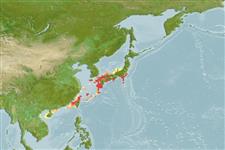Common names from other countries
>
Gobiiformes (Gobies) >
Gobiidae (Gobies) > Gobiinae
Etymology: Trimma: Greek, trimma, -atos = something crushed (Ref. 45335); kudoi: Named for Mr. Takahiro Kudo, who provided the holotype of the new species..
Environment: milieu / climate zone / depth range / distribution range
Ecologia
marinhas demersal; intervalo de profundidade 27 - 45 m (Ref. 75202). Temperate
Northwest Pacific: Japan.
Tamanho / Peso / Idade
Maturity: Lm ? range ? - ? cm
Max length : 2.5 cm SL macho/indeterminado; (Ref. 75202)
Descrição suscinta
Chaves de identificação | Morfologia | Morfometria
Espinhos dorsais (total) : 7; Raios dorsais (total) : 9 - 10; Espinhos anais: 1; Raios anais : 9; Vértebras: 26. This species differs from its congeners in the following combination of characters; scales on predorsal midline absent; elongate spines of first dorsal fin absent; 5th pelvic-fin ray unbranched, 50-70% of 4th ray in length; basal membrane between innermost pelvic-fin rays 10-17% of length of 5th ray; a shallow or deep interorbital trough, no postorbital trough; nape with a slightly developed longitudinal ridge in the midline; longitudinal scales 22-23; head ground color and body bright yellow, with iris vivid yellow, 3 deep purple oblique lines margined by pink when fresh (Ref. 75202).
Ciclo de vida ou comportamento de acasalamento
Maturities | Reprodução | Spawnings | Egg(s) | Fecundities | Larvas
Suzuki, T. and H. Senou, 2008. Two new species of the gobiid fish genus Trimma (Perciformes: Gobioidei) from Southern Japan. Bull. Natl. Mus. Nat. Sci. Ser. A. Suppl. 2:97-106. (Ref. 75202)
Status na Lista Vermelha da UICN (Ref. 130435)
CITES (Ref. 128078)
Not Evaluated
Ameaça para os humanos
Harmless
Uso pelos humanos
Ferramentas
Relatórios especiais
Baixar XML
Fontes da internet
Estimates based on models
Preferred temperature (Ref.
115969): 20.6 - 22.7, mean 22.1 (based on 5 cells).
Índice de diversidade filogenética (Ref.
82804): PD
50 = 0.5000 [Uniqueness, from 0.5 = low to 2.0 = high].
Bayesian length-weight: a=0.01023 (0.00477 - 0.02194), b=3.02 (2.84 - 3.20), in cm Total Length, based on LWR estimates for this (Sub)family-body shape (Ref.
93245).
Resiliência (Ref.
120179): Elevada, tempo mínimo de duplicação da população menor que 15 meses (Preliminary K or Fecundity.).
Fishing Vulnerability (Ref.
59153): Low vulnerability (10 of 100).
